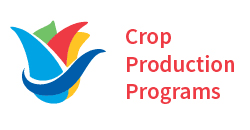
Garden Mum Fertilizer Tips & Programs
Different soilless mixes can be used, including mixtures of peat, perlite, bark and sand. The media should provide enough porosity and be well drained. However during outdoor production, the media should be heavy enough to withstand wind and not topple over. It should be able to retain enough moisture outside between irrigations to provide good nutrition. The pH of the media should be between 5.5 and 6, and the EC should be 1.5 mS.
Garden Mums are heavy feeders. They require fertilizer immediately upon planting rooted cuttings. Depending on water quality, various fertilizer programs may be followed.
Garden Mum fertilization, as with all crops, is dependent upon the quality of the irrigation water being used. High concentration of carbonates and bicarbonates will cause the pH of the media to rise during plant production. Water sources should be tested prior to deciding which fertilizer to apply. Options are available for various alkalinity levels. Acid injection (usually Sulfuric acid) is used when the alkalinity level is above 250 ppm CaCO3 for growers who want a consistent feed program. MPPI can provide water tests to determine your alkalinity level and general water nutrient levels. Based on your water analysis, we can determine which fertilizer schedule would work for you. When acid injection is used, Plantex® Solutions 17-5-17 Complete could be used as a the general feed. Where Ca/Mg is low, use Plantex 12-2-14 Cal Mag + P every third time.
If acid injection is not an alternative, rotation between acidic blends and a Cal Mag is suggested. The fertilizer analysis suggested would be determined by the water sample results but in general the following guidelines apply:
Water alkalinity between 75-100 ppm CaCO3 with low Cal/Mg levels:
Use Plantex Solutions 17-5-17 at 200-250 ppm N as a constant feed. Every third time use Plantex 12-2-14. Should the plants not size up enough due to climatic conditions, rotate with Plantex 20-10-20 All Purpose High N then return to Plantex Solutions 17-5-17. If EC levels drop below 2.5 mS, increase the feed to 300 ppm N. Monitor EC and pH.
Water alkalinity between 150-250 ppm CaCO3:
Option 1 – If acid injection is not being used and the Ca/Mg levels are low, use Plantex Solutions 19-8-13 Complete Plus. Every third time, fertilize with Plantex 12-2-14. If Ca/Mg levels are adequate, use Plantex 20-10-20 at 200-250 ppm N on a constant basis. If EC levels drop below 2.5 mS, increase the feed to 300 ppm N. Monitor EC and pH.
Option 2 – If acid injection is being used and the Ca/Mg levels are low, use Plantex Solutions 17-5-17 on a constant basis at 200-250 ppm N. Every third time, fertilizer with Plantex 12-2-14. If Ca/Mg levels are adequate, then use Plantex 20-10-20. If EC levels drop below 2.5 mS, increase the feed to 300 ppm N. Monitor EC and pH.
Water alkalinity greater than 250 ppm CaCO3:
Option 1 – If acid injection is not being used and the Ca/Mg levels are low, use Plantex Solutions 18-9-18 pH Reducer at 200-250 ppm N constant feed. Every third time, fertilize with Plantex 12-2-14. If Ca/Mg levels are adequate, use Plantex Solutions 18-9-18 at 200-250 pH on a constant basis. If EC levels drop below 2.5 mS, increase the feed to 300 ppm N. Monitor EC and pH.
Option 2 – If acid injection is being used and the Ca/Mg levels are low, use Plantex Solutions 19-8-13 at 200-250 ppm N constant feed. Every third time, fertilizer with Plantex 12-2-14. If Ca/Mg levels are adequate, use Plantex 20-10-20 at 200-250 ppm N constant feed. If EC levels drop below 2.5 mS, increase the feed to 300 ppm N. Monitor EC and pH.
In order to maintain plant quality during shipping and sale, fertilizer rates may be reduced 3 weeks prior to shipping, or when the buds are pea sized. Plantex Solutions 15-0-20 No-Stretch® should be used at 150-200 ppm N in order to strengthen the stems and to provide supplemental micronutrients to keep the finished plants greener.

- Plantex 12-2-14 Cal Mag + P Water Soluble Fertilizer
- Plantex 20-10-20 All Purpose High Nitrate Water Soluble Fertilizer
- Plantex Solutions 15-0-20 No-Stretch® Water Soluble Fertilizer
- Plantex Solutions 17-5-17 Complete Water Soluble Fertilizer
- Plantex Solutions 18-9-18 pH Reducer Water Soluble Fertilizer
- Plantex Solutions 19-8-13 Complete Plus Water Soluble Fertilizer

